Oil, gas, timber, gold: the Amazon rainforest is rich in resources, and their exploitation is booming. As resource extraction increases, so does the development of access roads and pipelines. These carve their way through previously intact forest, thereby interrupting the myriad pathways of the species that live there. For species that depend on the rainforest canopy, this can be particularly problematic. Home ranges become fragmented and species movements across habitats are disrupted, affecting the behavior, health, and genetic diversity of these species and consequently impacting broader ecosystem processes within the forest as a whole.
 Tremaine Gregory climbing in a canopy bridge. Photo credit: Farah Carrasco/Smithsonian Conservation Biology Institute. |
Now, a pioneering conservation project in the Peruvian Amazon is collaborating with a gas company to develop an effective way of mitigating some of these impacts. Natural canopy bridges have been left standing across a gas pipeline, and are being monitored by the highest network of camera traps ever deployed.
“In this project we are using more cameras, for more time, higher in the canopy than ever before. I can guess why other projects have not been so ambitious: placing a camera 100 feet above the forest floor is not easy!” Gregory says.
Gregory and her team have already recorded a huge range of species using the bridges (such as primates, kinkajous and anteaters), including one mammal species never before seen in the region.
Mongabay.com caught up with Tremaine Gregory, a Research Scientist at the Smithsonian Conservation Biology Institute, who is leading the project.
INTERVIEW WITH TREMAINE GREGORY
Mongabay: What is your background and how did you become a tropical biologist?
Gregory: I hold a Bachelor’s degree in Biology and Spanish, a Master’s in Anthropology, and a Ph.D. in Biological Anthropology. I recently told someone that I am a neotropical primate behavioral ecologist and conservation biologist, although in Peru I tend to refer to myself as a “mono-loga.” I came to this career through many twists and turns (Peace Corps volunteer, Spanish medical interpreter, wild trout biologist, veterinary assistant (of course), theatre technician), in search of a life that would be meaningful and fulfill both my dedication to understanding and conserving wildlife and as well as my love for adventure.
Mongabay: Your previous research investigated the little-known Guianan bearded saki monkey (Chiropotes sagulatus) in Suriname, can you tell us about what you found in that study?
Gregory: For about six years I worked in Suriname studying both the bearded saki monkey and the white-faced saki monkey (Pithecia pithecia). My Master’s research contributed to our understanding of the evolution and niche divergence of these two species. During my dissertation research, I had the opportunity to spend 13 months in the field focusing on bearded saki ecology and social behavior. The bearded saki has been studied very little in continuous forest in the wild. This is largely due to the fact that these monkeys are exceedingly difficult to study—they travel through the huge, emergent trees at the top of the canopy, and they live in very large, fast moving groups. Trying to keep one eye on them while running across the forest floor can be a challenge. It’s amazing how easy it is to lose track of 40 monkeys. My research explored how the monkeys potentially use the forest’s complex topography strategically to reduce the costs of travel. I’ve also contributed to our understanding of bearded saki social behavior, particularly with regards to the relationships between males. Male bearded sakis seem to be highly affiliative with one another, showing signs of very tight bonds. There is also evidence of sexual mimicry and other unique characteristics. I look forward to returning to Suriname someday to delve back into many fascinating questions that remain about this group of monkeys.
 Tamandua (Tamandua tetradactyla) with baby. Photo courtesy of the Smithsonian Conservation Biology Institute.
Tamandua (Tamandua tetradactyla) with baby. Photo courtesy of the Smithsonian Conservation Biology Institute.
Mongabay: What is the main aim of your current work in Peru?
Gregory: The goal of my current work in the Peruvian Amazon is to provide scientifically sound recommendations to industrial development companies that operate in tropical forests to reduce their impact. I know that industrial development in the Amazon Basin will continue, and as a conservationist, I hope to do as much as possible to limit its impact.
In the Lower Urubamba Region of Peru, I am working in an area where a natural gas pipeline is being constructed. In order to install the pipeline, a swath is cut through the forest. This swath can be over 16 meters (53 feet) wide, and it eliminates connectivity of the forest canopy overhead. The good news is that the pipe is buried and the swath is reforested, but during the five to ten years it takes for the canopy to reconnect, arboreal animals can become isolated on either side. Some animals may venture down to the ground to cross, but doing so can be dangerous, and our results so far suggest that they do so very rarely. In order to reduce the fragmentary effect caused by the pipeline swath, the company with which we are working agreed to leave connections above the pipeline to preserve some connectivity. We call the connections “natural canopy bridges” because they are made up of the branches of the largest trees that connect over the top of the swath. Before pipeline construction began, I walked back and forth along the proposed pipeline path with my team mapping out locations where it looked like the branches would connect after clearing. We then worked with the construction company to preserve the trees that connected. Leaving the trees can be challenging for operations, so this required careful coordination. In the end, there were 13 canopy bridges, and we are now testing whether animals use them.

Black-capped capuchin monkey (Sapajus apella). Photo courtesy of the Smithsonian Conservation Biology Institute.

Dwarf porcupine (species yet to be determined). Photo courtesy of the Smithsonian Conservation Biology Institute.
Mongabay: How widespread are infrastructure development projects in the Amazon, such as the one you are working on?
Gregory: Most of the Western Amazon is zoned for hydrocarbon exploration (Finer et al. 2008; Finer and Orta-Martínez 2010), and in 2012, over half of the Peruvian Amazon was under concession (there are detailed maps available on the Perupetro website: http://www.perupetro.com.pe/). However, while these numbers may seem surprising, it is important to understand that within a concession block, a corporation will generally do some seismic research and drill a few exploratory wells, impacting a relatively small proportion of this area (see “Effective Area of Work” on Perupetro maps). In fact, pockets of natural gas or oil large enough to lead to the construction of a pipeline are very rare. Industry environmental standards have become strict, and many corporations use the off-shore model for their operations. This model simply means that corporations do not create access roads but instead treat operations camps as if they were “offshore,” and all access is by helicopter. All of this is to say that hydrocarbon exploration and extraction activity has the potential to impact a large part of the Amazon Basin, and my research explores ways to keep that impact to as much of a minimum as possible.
Mongabay: Why is it important to ensure the connectivity of populations?
Gregory: There are many reasons why it is important to maintain canopy connectivity and gene flow between populations of animals. First of all, when populations become isolated, the gene pool shrinks. With reduced genetic diversity, animals are more susceptible to disease and inbreeding depression. This, in turn, affects their survival and can even lead to localized extinctions. Another problem with fragmenting the area used by a community of animals is that they lose access to resources. Animals have complex mental maps that help them remember the location of feeding resources and shelter in their environment. They also are likely to have knowledge of neighboring individuals or groups of animals—information important for territorial and mating decisions. When an animal’s or group of animals’ home range is divided, they lose access to those resources. The area they use shifts, and they are forced into unknown territory. This can affect survival by influencing nutrition and increasing stress through augmented search time for resources and conflict with novel groups of animals. Effects on arboreal animals can then affect the forest as a whole. Many primates, for example, are seed dispersers. This means that they eat fruits, swallow the seeds, and after the seeds pass through their gut, they drop them in a different location. This is an extremely important process that contributes to the survival of the fruit tree species, and from a broad perspective to the function of the ecosystem as a whole.

Peruvian night monkeys (Aotus nigriceps) with baby. Photo courtesy of the Smithsonian Conservation Biology Institute.
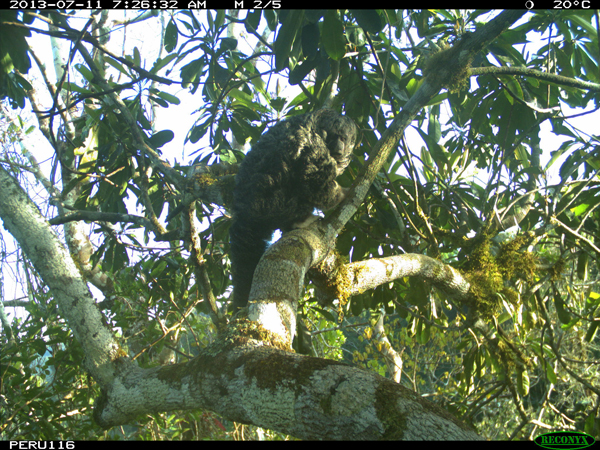
Bald-faced saki (Pithecia irorrata). Photo courtesy of the Smithsonian Conservation Biology Institute.
Mongabay: Have camera traps been used in the forest canopy before?
Gregory: In this project we are using more cameras, for more time, higher in the canopy than ever before. I can guess why other projects have not been so ambitious: placing a camera 100 feet above the forest floor is not easy! It took me and Farah Carrasco, my Peruvian collaborator, two weeks to place our 25 canopy cameras, and keeping them running for a year has been a major challenge. The conditions for the cameras are much harsher in the canopy than they are on the ground. More of our canopy cameras (we have another 55 cameras on the ground) have been invaded by ants, and they are exposed to more wind, constant sun and rain, and extremely tenacious animals like porcupines who enjoy gnawing on and opening them.
Mongabay: How do you install and monitor the camera traps?
Gregory: Installing camera traps in the high canopy is quite an adventure. When we decided we needed to monitor the canopy bridges with camera traps, we realized we needed to learn how to climb trees—tropical trees. Off we went to a tree climbing course in Panama. There we learned to use a seven-foot-tall sling shot to place a climbing line in a tree. But getting up into the tree was just the beginning. In some cases it took us upwards of five hours to figure out where the camera should go to capture the crossing point, transfer between branches to reach that point, then place and test the camera—all the while trying to remember not to drop anything. My dad and I designed a mounting system with two ball joints, allowing the camera to be angled in any direction. Cameras on the ground can just be bungeed to a tree trunk, but the canopy is a more complex, three dimensional world. I’m currently working on a manuscript that describes our methods in detail so that other researchers may benefit from what we’ve learned.
Mongabay: What is it like climbing such enormous trees?
Gregory: Climbing canopy trees is exhilarating, to say the least! As I bustle around juggling the cameras and ropes and things, I have to remind myself to stop, take in the view, and feel the breeze. I think the most fascinating part has been experiencing a world that I had only observed from below. After years of watching monkeys in the canopy through binoculars, it is an entirely different experience to be in the top of a tree. You realize that rather than a plane-like environment, like the forest floor, the canopy is a network of linear pathways, and a false move can be very costly.

Kinkajou, Potos flavus. Photo courtesy of the Smithsonian Conservation Biology Institute.
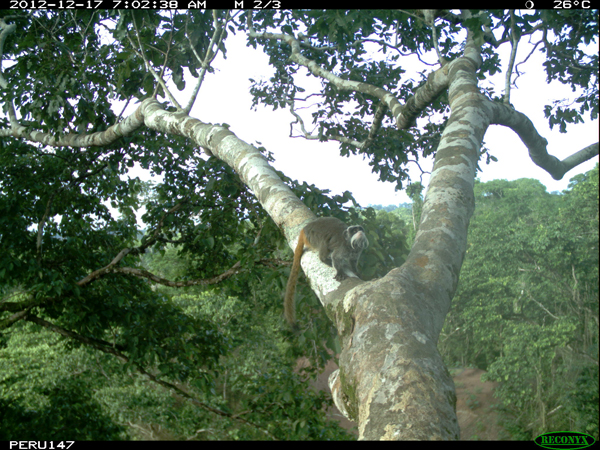
Emperor tamarin (Saguinus imperator). Photo courtesy of the Smithsonian Conservation Biology Institute.
Mongabay: Have you been surprised by any of the camera trap footage, and have there been any unexpected species using the bridges?
Gregory: So many of the camera trap photos are breath-taking. I have to discipline myself to avoid spending all day marveling at photos of monkeys, kinkajous, anteaters, opossums, and many other animals. In addition to mammal species, we’ve had many photos of birds and even reptiles. I usually take a quick look at the photos while up in the tree to make sure the camera is working properly, and my guides are accustomed to hearing me exclaim over the photos. In camp in the evening, everyone gathers round to see what goodies we’ve brought back on the memory cards. One of our many exciting finds has been an arboreal dwarf porcupine species that was not known to occur within 800km of the study area. Others include some spectacular photos of saki monkeys and anteaters with their babies. These really blew me away. If you haven’t been up in the tree to see the camera, it’s hard to imagine that the animals are actually up so high.

The canopy bridge research team this past October. Photo credit: Smithsonian Conservation Biology Institute.
Mongabay: Do you know yet how successful the canopy bridges have been? Are they likely to be effective enough to mitigate all impacts of the pipeline on these arboreal species?
Gregory: Interestingly, arboreal animals were already using the bridges immediately after they were exposed by the construction activities. I thought it would take them some time to locate the crossing branches, but they had no trouble finding them. The bridges have been used by over 20 species of arboreal mammals, and we recorded over 1,000 crossing events in the first six months. Because the canopy was continuous before construction, we could not monitor all possible crossing branches in order to make before and after comparisons. The 13 bridges are spread over a five-kilometer (three-mile) area, so potential crossing options have been dramatically reduced, likely leading to fewer crossings, overall. I would therefore not say that the bridges have mitigated ALL impacts, per se. Our monitoring has also suggested that groups of primates may migrate away from the area during construction. However, we’ve also had very few recordings of crossings by arboreal animals on the ground, suggesting that the bridges have been a huge success, allowing animals to continue to access feeding resources, shelter, and social partners on either side of the swath. We plan to recommend that all pipeline projects in tropical rainforest habitats include canopy bridges.
Mongabay: What about in situations where the largest trees have already been felled – could there be a role for artificial bridges to help mitigate the impact of development projects that have already been completed?
Gregory: That’s a good question and one that many people have asked me. In future research, I hope to address that question. I imagine that animals would be inclined to use artificial bridges, particularly over roads, where there can be continuous activity. There are projects all over the world that are using different types of artificial bridges or crossing structures. One major difference, however, between natural bridges and artificial bridges is that animals must habituate to the artificial bridges. While we observed animals using the natural bridges within days after they were exposed, I understand that it can take many months for animals to feel safe enough to use artificial bridges. In this time, they lose access to resources on the other side. With proper planning, natural bridges should also be cheaper and require less maintenance. But certainly, where there are no bridges, artificial bridges are a good solution.
Mongabay: Being able to monitor species before, during and after the pipeline construction must be crucial to understanding the effectiveness of the bridges – was it difficult to initiate collaboration with the company building the pipeline?
Gregory: While this is my first collaboration with a large corporation, the Center in which I work (the Smithsonian Conservation Biology Institute’s Center for Conservation Education and Sustainability) has over a decade of experience around the world, with multiple corporations. We therefore have a good reputation both in the world of conservation and with industry. And while the goals of conservation and industry can be very different, I think there is a surprising amount of common ground to be found. Particularly in recent years, corporations have begun to pay more and more attention to conservation issues. While this project has been very challenging, I think it is a great example of the positive conservation outcomes that can be achieved through partnerships.
Mongabay: What are your future research plans?
Gregory: With over one million camera trap photos from a year of data collection on this project, at the moment, I am focused on data analysis and publication. I also look forward to providing recommendations to corporations and the Peruvian government on the mitigation benefits of canopy bridges. After that, I look forward to exploring new ways to help corporations reduce their impacts. While I miss working in a national park, as I did as a graduate student, and find working in concession blocks with corporations to be much more challenging, I know that as a conservation biologist this line of research is where I can be most effective. But, if I can sneak in a trip to Suriname to catch sight of a bearded saki, I’m unlikely to pass it up!

Dwarf porcupine (species yet to be determined). Photo courtesy of the Smithsonian Conservation Biology Institute.

Tremaine Gregory and Farah Carrasco. Photo credit: Joe Maher/Smithsonian Conservation Biology Institute.
Citations:
- Finer M, Jenkins CN, Pimm SL, Keane B, Ross C. 2008. Oil and gas projects in the Western Amazon: Threats to wilderness, biodiversity, and indigenous peoples. PLoS ONE 3(8).
- Finer M, Orta-Martínez M. 2010. A second hydrocarbon boom threatens the Peruvian Amazon: Trends, projections, and policy implications. Environmental Research Letters 5:1-10.
Related articles
Asia’s ‘unicorn’ photographed in Vietnam
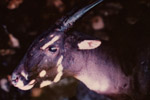
(11/12/2013) In 1992, scientists made a spectacular discovery: a large, land mammal (200 pounds) that had somehow eluded science even as humans visited the moon and split the atom. Its discoverers, with WWF and Vietnam’s Ministry of Forestry, dubbed the species the saola (Pseudoryx nghetinhensis). Found in the Annamite Mountains in Laos and Vietnam, the saola is a two-horned beautiful bovine that resembles an African antelope and, given its rarity, has been called the Asian unicorn. Since its discovery, scientists have managed to take photos via camera trap of a wild saola (in 1999) and even briefly studied live specimens brought into villages in Laos before they died (in 1996 and again in 2010), however the constant fear of extinction loomed over efforts to save the species. But WWF has announced good news today: a camera trap has taken photos of a saola in an unnamed protected area in Vietnam, the first documentation of the animal in the country in 15 years.
Could camera trap videos galvanize the world to protect Yasuni from oil drilling?

(11/07/2013) Even ten years ago it would have been impossible to imagine: clear-as-day footage of a jaguar plodding through the impenetrable Amazon, or a bicolored-spined porcupine balancing on a branch, or a troop of spider monkeys feeding at a clay lick, or a band of little coatis racing one-by-one from the dense foliage. These are things that even researchers who have spent a lifetime in the Amazon may never see. Now anyone can: scientists at the Tiputini Biodiversity Station in Ecuador’s Yasuní National Park have recently begun using camera trap videos to take movies of animals few will ever view in their lifetimes. The videos—following years of photo camera trapping—provide an intimate view of a world increasingly threatened by the oil industry.
World’s most cryptic feline photographed in logging concession

(11/04/2013) The bay cat is arguably the world’s least-known member of the cat family (Felidae). Although first described by scientists in 1874, no photo existed of a living specimen until 1998 and a wild cat in its rainforest habitat wasn’t photographed until five years later. Given this, scientists with Zoological Society of London (ZSL) and Imperial College London were taken aback when their remote camera traps captured numerous photos of these elusive cats hanging out in a commercial logging concession in Sabah, a state in Malaysian Borneo.
Armored giant turns out to be vital ecosystem engineer
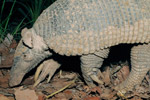
(10/24/2013) The giant armadillo (Priodontes maximus) is not called a giant for nothing: it weighs as much as a large dog and grows longer than the world’s biggest tortoise. However, despite its gigantism, many people in its range—from the Amazon to the Pantanal—don’t even know it exists or believe it to be more mythology than reality. This is a rare megafauna that has long eluded not only scientific study, but even basic human attention. However, undertaking the world’s first long-term study of giant armadillos has allowed intrepid biologist, Arnaud Desbiez, to uncovered a wealth of new information about these cryptic creatures. Not only has Desbiez documented giant armadillo reproduction for the first time, but has also discovered that these gentle giants create vital habitats for a variety of other species.
Featured video: bears work together to take down camera traps
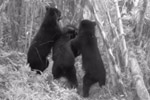
(10/24/2013) Scientists with the Wildlife Conservation Society (WCS) have captured stunning images of Andean bear families taking down camera traps in Bolivia’s Apolobamba National Natural Area of Integrated Management. In one series of images a mother and her two cubs bite, claw, and whack one of the cameras. However even as they destroy one camera, the bears’ antics are captured by another as researchers typically set several cameras to capture different views of animals, a process that helps them identify individuals.
Honey badgers and more: camera traps reveal wealth of small carnivores in Gabon (photos)
.150.jpg)
(10/17/2013) Gabon has lost most of its big meat-eaters including lions, spotted hyenas, and African wild dogs (although it’s still home to leopards), but a new study focuses on the country’s lesser-known species with an appetite for flesh. For the first time, researchers surveyed Gabon’s small carnivores, including 12 species from the honey badger (Mellivora capensis) to the marsh mongoose (Atilax paludinosus).